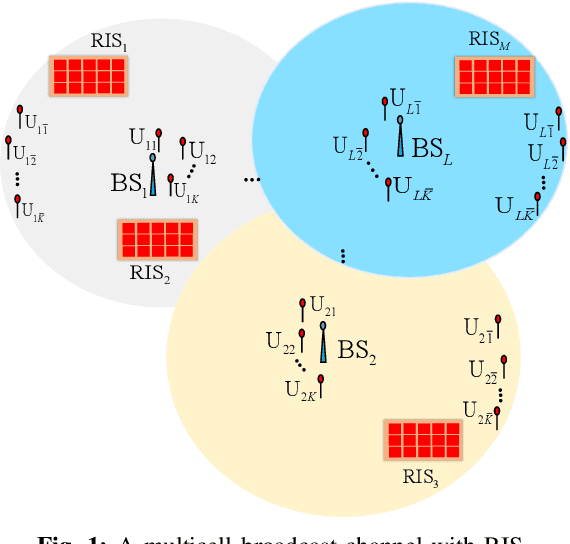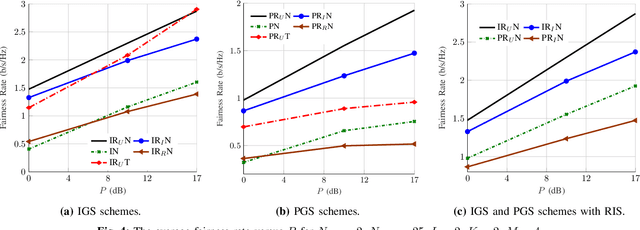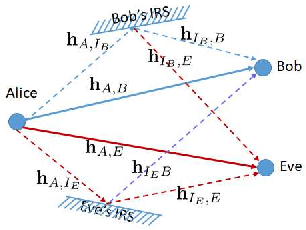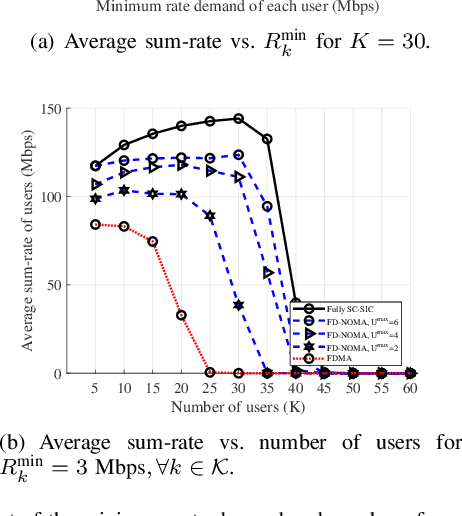Sepehr Rezvani
NOMA-based Improper Signaling for Multicell MISO RIS-assisted Broadcast Channels
Jun 08, 2022



Abstract:In this paper, we study the performance of reconfigurable intelligent surfaces (RISs) in a multicell broadcast channel (BC) that employs improper Gaussian signaling (IGS) jointly with non-orthogonal multiple access (NOMA) to optimize either the minimum-weighted rate or the energy efficiency (EE) of the network. We show that although the RIS can significantly improve the system performance, it cannot mitigate interference completely, so we have to employ other interference-management techniques to further improve performance. We show that the proposed NOMA-based IGS scheme can substantially outperform proper Gaussian signaling (PGS) and IGS schemes that treat interference as noise (TIN) in particular when the number of users per cell is larger than the number of base station (BS) antennas (referred to as overloaded networks). In other words, IGS and NOMA complement to each other as interference management techniques in multicell RIS-assisted BCs. Furthermore, we consider three different feasibility sets for the RIS components showing that even a RIS with a small number of elements provides considerable gains for all the feasibility sets.
Legitimate against Illegitimate IRSs on MISO Wiretap Channels
Mar 24, 2022

Abstract:The low-cost legitimate intelligent reflecting surfaces (IRSs) are applied to the wiretap channel in physical layer security to enhance the secrecy rate. In practice, the eavesdropper can also deploy an IRS, namely illegitimate IRS, to deteriorate the secrecy rate. This paper studies the interplay between a transmitter, a legitimate IRS, and an illegitimate IRS in a multiple-input single-output (MISO) wiretap channel. We formulate a max-min secrecy rate problem, where all the information is available at the transmitter and the receivers. We aim to design an efficient transmit beamforming and phase shifting strategy of the legitimate IRS, under the worst-case secrecy rate achieved based on optimizing the phase-shifting strategy of the illegitimate IRS. We propose three solution methods based on the gradient descent ascent (GDA), the alternate optimization (AO), and the mixed Nash equilibrium (NE) in zero-sum games in strategic form. Simulation results show that for the continuous phase-shifting strategies, AO usually does not guarantee convergence, although it may achieve better performance than GDA in some iterations. GDA usually converges to a stationary point. Discrete phase-shifting strategies improve the convergence behavior of AO and GDA, while there is a single mixed NE with the highest secrecy rate.
Optimal Power Allocation in Downlink NOMA
Jul 14, 2021



Abstract:Power-domain non-orthogonal multiple access (NOMA) has arisen as a promising multiple access technique for the next-generation wireless networks. In this work, we address the problem of finding globally optimal power allocation strategies for the downlink of a generic single-cell NOMA system including multiple NOMA clusters each operating in an isolated resource block. Each cluster includes a set of users in which the well-known superposition coding (SC) combined with successive interference cancellation (SIC) technique (called SC-SIC) is applied among them. Interestingly, we prove that in both the sum-rate and energy efficiency maximization problems, network-NOMA can be equivalently transformed to a virtual network-OMA system, where the effective channel gain of these virtual OMA users are obtained in closed-form. Then, the latter problems are solved by using very fast water-filling and Dinkelbach algorithms, respectively. The equivalent transformation of NOMA to the virtual OMA system brings new insights, which are discussed throughout the paper. Extensive numerical results are provided to show the performance gap between fully SC-SIC, NOMA, and OMA in terms of system outage probability, BS's power consumption, users sum-rate, and system energy efficiency.
Optimal Water-Filling Algorithm in Downlink Multi-Cluster NOMA Systems
Jun 16, 2021



Abstract:The key idea of power-domain non-orthogonal multiple access (NOMA) is to exploit the superposition coding (SC) combined with successive interference cancellation (SIC) technique (called SC-SIC) while reducing the receivers' complexity as well as error propagation. Actually, NOMA suggests a low-complexity scheme, where users are grouped into multiple clusters operating in isolated resource blocks, and SC-SIC is performed among users within each cluster. In this paper, we propose a globally optimal joint intra- and inter-cluster power allocation for any arbitrary user grouping to maximize users' sum-rate. In this algorithm, we exploit the closed-form of optimal intra-cluster power allocation obtained in our previous work. Then, by transforming network-NOMA to an equivalent virtual network-OMA, we show that the optimal power allocation can be obtained based on the very fast water-filling algorithm. Interestingly, we observe that each NOMA cluster acts as a virtual OMA user whose effective channel gain is obtained in closed form. Also, each virtual OMA user requires a minimum power to satisfy the minimum rate demand of its real multiplexed user. In simulation results, we evaluate the performance gap between fully SC-SIC, NOMA, and OMA, in terms of users sum-rate, and outage probability.
 Add to Chrome
Add to Chrome Add to Firefox
Add to Firefox Add to Edge
Add to Edge